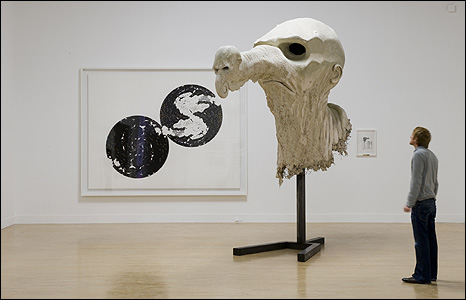Altermodern showing at the Tate Britain until 26th April 2009 asks the question ‘What comes after post-modernism’? Which is why I went to see it, despite being exhausted after visiting the thoroughly wonderful Annette Messager exhibition (of which more later).
There was enough there to keep me awake – even to get me excited. The show is curated by Nicolas Bourriaud, who coined the term ‘Altermodern’ to describe how artists are responding to the globalised world in which we live. He describes the exhibition as an ongoing dialogue, inviting the artists to respond to the question of what comes after post-modernism, and to the Altermodern manifesto .
Highlights for me included Charles Avery, who showed an installation of drawings positioned around the ‘Aleph Null Head’ sculpture shown above. These are from his ongoing project ‘The Islanders’, in which he is creating an imaginary island through drawings, texts and objects, meticulously documenting the islands topography, inhabitants, vegetation and creatures. One beautiful drawing, confidently executed in pencil, ink and gouache, depicts strange dog/horse like creatures with bird legs who are in the process of catching and devouring seagulls.
In Loris Greaud’s installation ‘Tremors where forever (frequency of an image, white edit)’, a room is filled with white boxes on the floor, each with wires trailing into a perspex ‘control’ box in the centre of the room, where tiny lights flash on and off indicating some sort of activity. As you walk into the room, you realise that parts of the floor vibrate beneath your feet, then the tremors stop again. Intrigued, I turned to the page in the brochure, to find that the installation represents a 30 minute recording of the artist’s own brain activity. The recorded brainwaves have been converted into electrical frequencies which are broadcast to the vibrators. Thus as a viewer, I am physically experiencing the thoughts of the artist.
Simon Starling’s ‘Three White Desks’ recreates an alleged story of Francis Bacon designing a desk for an Australian Writer. The artist asks three cabinet makers to recreate the desk purely from a photograph, and the resulting desks are on display perched on top of the crates in which they arrived at the Tate gallery. There is also a group of photographs ‘documenting the evidence’ of the original desk. The brochure explains that Starling takes examples of early modernist design and ‘puts them through a process of transformation, relocation or manipulation, drawing out convoluted narratives about their fabrication and the network of relationships they embody.’ For me, it seemed like an ironic look at the way we construct ‘facts’ out of the fragmented stories of history, and try to recreate them as solid ‘truths’ together with all the paraphenalia of mock-ups, models, photographs and diagrams. I wasn’t (and am still not) even sure that the original story about Bacon was true. Even if it is, why pick on that story? I liked it in the way it reminded me to question everything, take nothing at face value, and ask ‘why does the narrator/recreator want to convince us of this story?’
The most exciting video installation for me (and there was a lot of video in the exhibition) was Lindsay Seers’ ‘Extramission 6 (Black Maria), shown in a wooden house-type construction. Whilst I didn’t see all of it (I do wish they would display running times on video installations), I saw enough to become entranced by the story of a woman who wanted to become a camera, and then a slide projector, told using the documentary strategy of ‘interviewing’ the friends and family of the afflicted woman, interspersed with clips of her performing her function as camera and then slide projector. This loses a lot in translation, and really has to be viewed.
Whilst this wasn’t my favourite exhibition of the weekend trip, it did provide food for thought, and a glimpse of how artists are responding to the world beyond ‘post-modernism’.
